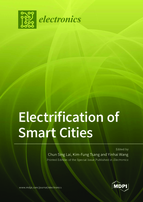Electrification of Smart Cities
A special issue of Electronics (ISSN 2079-9292). This special issue belongs to the section "Computer Science & Engineering".
Deadline for manuscript submissions: closed (31 December 2021) | Viewed by 13822
Special Issue Editors
Interests: smart energy management; smart grids; smart battery management systems; power system optimization; energy system modeling; data analytics; electric vehicle systems; hybrid powertrains optimization; energy economics for renewable energy and storage systems
Special Issues, Collections and Topics in MDPI journals
Interests: Internet of Things standards; sensors; wireless protocols; network optimization; emerging networks of Internet of Things; artificial intelligence for smart applications; blockchain and cyber security for Internet of Things
Special Issues, Collections and Topics in MDPI journals
Interests: infrastructure and smart cities; transportation engineering; traffic detection systems
Special Issues, Collections and Topics in MDPI journals
Special Issue Information
Dear Colleagues,
Electrification plays a key role in decarbonizing energy consumption for various sectors, including transportation, heating, and cooling. There are several essential infrastructures for a smart city, including smart grids and transportation networks. These infrastructures are the complementary solutions to successfully developing novel services, with enhanced energy efficiency and energy security.
This Special Issue seeks high-quality papers that address issues related to cutting-edge smart city technologies in the electrification process. Topics of interest for this Special Issue include, but are not limited to:
- Electrification of building environments and transportation systems;
- Role and impact of smart grids for smart cities;
- ICT and IoT infrastructures with big data for smart cities electrification;
- Market, services, and business models for smart cities electrification;
- Standards and implementation for smart cities electrification;
- Advanced smart grid technology integration in smart cities, such as energy storage, demand-side management, and distributed energy resources.
Dr. Chun Sing Lai
Dr. Kim-Fung Tsang
Prof. Yinhai Wang
Guest Editors
Manuscript Submission Information
Manuscripts should be submitted online at www.mdpi.com by registering and logging in to this website. Once you are registered, click here to go to the submission form. Manuscripts can be submitted until the deadline. All submissions that pass pre-check are peer-reviewed. Accepted papers will be published continuously in the journal (as soon as accepted) and will be listed together on the special issue website. Research articles, review articles as well as short communications are invited. For planned papers, a title and short abstract (about 100 words) can be sent to the Editorial Office for announcement on this website.
Submitted manuscripts should not have been published previously, nor be under consideration for publication elsewhere (except conference proceedings papers). All manuscripts are thoroughly refereed through a single-blind peer-review process. A guide for authors and other relevant information for submission of manuscripts is available on the Instructions for Authors page. Electronics is an international peer-reviewed open access semimonthly journal published by MDPI.
Please visit the Instructions for Authors page before submitting a manuscript. The Article Processing Charge (APC) for publication in this open access journal is 2400 CHF (Swiss Francs). Submitted papers should be well formatted and use good English. Authors may use MDPI's English editing service prior to publication or during author revisions.
Keywords
- Electrification of building environments and transportation systems
- Role and impact of smart grids for smart cities
- ICT and IoT infrastructures with big data for smart cities electrification
- Market, services and business models for smart cities electrification
- Standards and implementation for smart cities electrification
- Advanced smart grid technology integration in smart city such as energy storage, demand side management, and distributed energy resources








